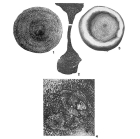Foraminifera taxon details
Orbitopsella Munier-Chalmas, 1902 †
738432 (urn:lsid:marinespecies.org:taxname:738432)
accepted
Genus
Orbitolites praecursor Gümbel, 1872 † accepted as Orbitopsella praecursor (Gümbel, 1872) † (type by original designation)
Coskinolinopsis Henson, 1948 † · unaccepted (Subjective junior synonym in...)
Subjective junior synonym in opinion of Loeblich and Tappan (1987)
marine, brackish, fresh, terrestrial
fossil only
feminine
Munier-Chalmas, E. (1902). Sur les Foraminifères rapportés au groupe des Orbitolites. <em>Bulletin de la Société géologique de France.</em> (4) 2 (3): 351-353., available online at https://biodiversitylibrary.org/page/30750132
page(s): p. 351 [details]
page(s): p. 351 [details]
Diagnosis Test large, up to 18 mm in diameter, flabelliform to discoid, and may have much thickened outer margin due to the rapid...
Diagnosis Test large, up to 18 mm in diameter, flabelliform to discoid, and may have much thickened outer margin due to the rapid proliferation of entire planes of pillars and intervening openings, early microspheric stage with tiny proloculus followed by reduced planispiral to peneropliform nepionic stage and then by many narrow annular chambers that form a discoid test; large and complex megalospheric embryonal apparatus with protoconch of one or more chambers and a relatively wellpreserved spheroconch, followed by a peneropliform nepionic stage, and then a reniform or annular growth stage; wall agglutinated, with thick exoskeletal walls and a row of short beams aligned from chamber to chamber but that may be offset by the intercalation of additional beams to maintain equal spacing as the chambers rapidly enlarge, massive septa may equal the thickness of the chamber cavity, endoskeletal pillars arise on the distal face of the septum and cross the chamber to the proximal face of the next septum, additional pillars are intercalated as the test enlarges; septa perforated by numerous openings that are radially aligned from one chamber to the next, and occur in planes parallel both to the faces of the disc and to the endoskeletal pillars, aperture consisting of similar openings on the final chamber face. L. Jurassic (Liassic); Italy; Cyprus; Yugoslavia; Greece; Mallorca; Morocco; Iran; Oman; Arabia; China: Markam region. (Loeblich & Tappan, 1987, Foraminiferal Genera and Their Classification) [details]
Hayward, B.W.; Le Coze, F.; Vachard, D.; Gross, O. (2025). World Foraminifera Database. Orbitopsella Munier-Chalmas, 1902 †. Accessed at: https://www.marinespecies.org/Foraminifera/aphia.php?p=taxdetails&id=738432 on 2025-05-23
Date
action
by
original description
Munier-Chalmas, E. (1902). Sur les Foraminifères rapportés au groupe des Orbitolites. <em>Bulletin de la Société géologique de France.</em> (4) 2 (3): 351-353., available online at https://biodiversitylibrary.org/page/30750132
page(s): p. 351 [details]
original description (of Coskinolinopsis Henson, 1948 †) Henson, F. R. S. (1948). Larger imperforate foraminifera of south-western Asia. Families Lituolidae, Orbitolinidae and Meandropsinidae. <em>British Museum (Natural History).</em> 1-127.
page(s): p. 27 [details] Available for editors [request]
[request]
page(s): p. 351 [details]
original description (of Coskinolinopsis Henson, 1948 †) Henson, F. R. S. (1948). Larger imperforate foraminifera of south-western Asia. Families Lituolidae, Orbitolinidae and Meandropsinidae. <em>British Museum (Natural History).</em> 1-127.
page(s): p. 27 [details] Available for editors
From editor or global species database
Diagnosis Test large, up to 18 mm in diameter, flabelliform to discoid, and may have much thickened outer margin due to the rapid proliferation of entire planes of pillars and intervening openings, early microspheric stage with tiny proloculus followed by reduced planispiral to peneropliform nepionic stage and then by many narrow annular chambers that form a discoid test; large and complex megalospheric embryonal apparatus with protoconch of one or more chambers and a relatively wellpreserved spheroconch, followed by a peneropliform nepionic stage, and then a reniform or annular growth stage; wall agglutinated, with thick exoskeletal walls and a row of short beams aligned from chamber to chamber but that may be offset by the intercalation of additional beams to maintain equal spacing as the chambers rapidly enlarge, massive septa may equal the thickness of the chamber cavity, endoskeletal pillars arise on the distal face of the septum and cross the chamber to the proximal face of the next septum, additional pillars are intercalated as the test enlarges; septa perforated by numerous openings that are radially aligned from one chamber to the next, and occur in planes parallel both to the faces of the disc and to the endoskeletal pillars, aperture consisting of similar openings on the final chamber face. L. Jurassic (Liassic); Italy; Cyprus; Yugoslavia; Greece; Mallorca; Morocco; Iran; Oman; Arabia; China: Markam region. (Loeblich & Tappan, 1987, Foraminiferal Genera and Their Classification) [details]
From editor or global species database
Image from typetaxon
Unreviewed


